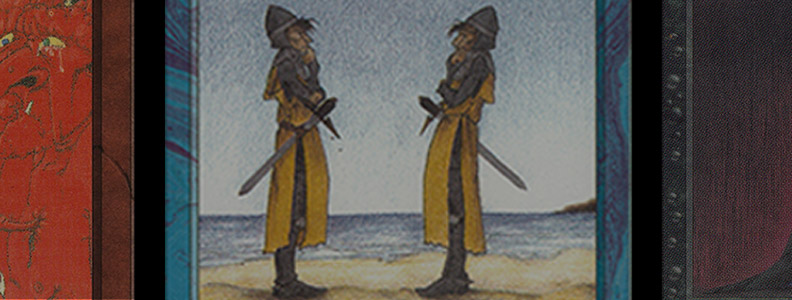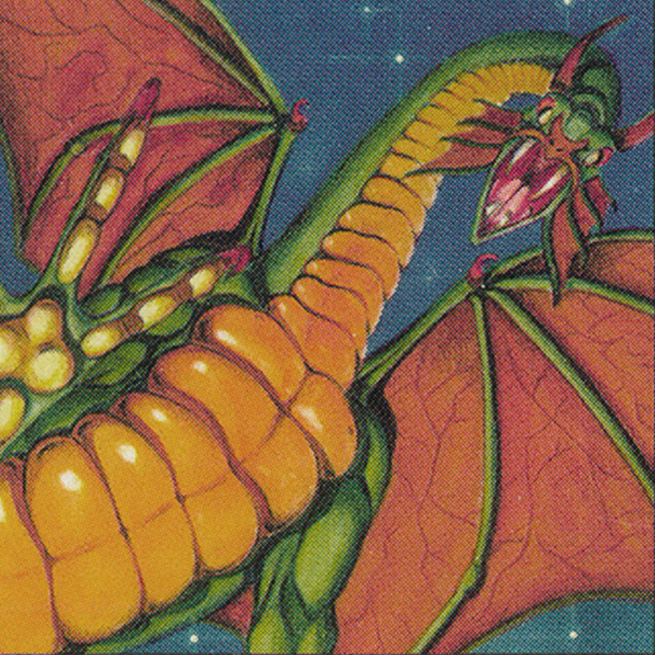Welcome to our MTG artists interview series, entry number #28!
We had the pleasure of talking with Julie - who is one of the original 25 Magic artists - over Skype, and she shared some incredible stories with us.
We're truly excited and incredibly grateful to be able to share this interview with you today. Enjoy! "Each piece I did back then has a story behind it"

Hi Julie! Would you introduce yourself?
My name is Julie Baroh. In terms of Magic, I'm probably better known as one of the earlier Magic artists. I worked on the game up until 1997.
How did you start?
Like a lot of artists, I was drawing since I was really little. I actually wanted to be a writer, but ended up applying and getting into a local private art school in Seattle called Cornish College of the Arts. My classmates at the time were people you guys all know, like Jesper Myrfors [Jesper was the original Art Director, and one of the 25 original artists], Sandra Everingham, Amy Weber, Cornelius Brudi, I think Drew Tucker and Anson [All part of the 25 original Magic artists] were also going to school there.
Things changed dramatically in my third year: Jesper Myrfors was running around all super excited about a game he was working on. The problem was that the company, which was Wizards of the Coast, was kinda cash poor, and couldn't afford some of the top notch illustrators around that time, so he was actually calling the student body of our school looking for people who might be interested in working on this game.
This private school was really expensive, and I was putting myself through it, so I was really, really broke. At the time they payed 50 bucks a card, that might not be much for a regular freelance illustrator but to a student who is living off mac and cheese that was grocery money, so I was like "Ok sure!".
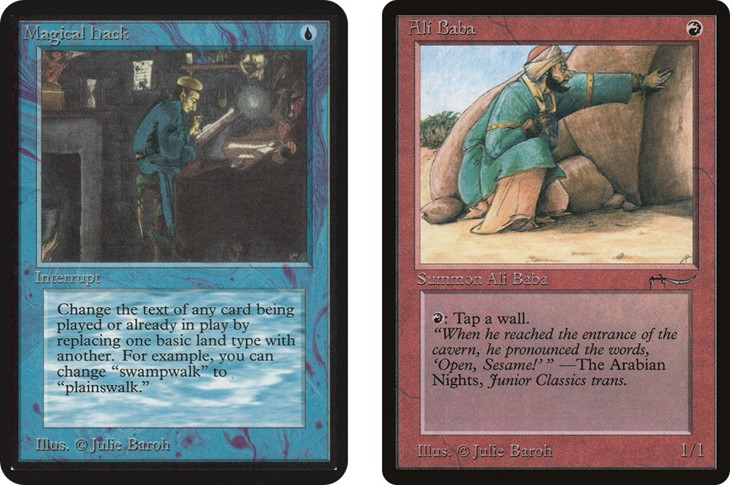
I was neck deep on both school, work and curating an art show, so I was really tied on time, that's why I only took four cards. I was offered quite a bit more, as they had quite a few cards at that time available, but I honestly had no clue how big the game would ever get.
So I let Jesper pick the cards out for me, as there was so little information about the game and how it played. On one hand, it was really awesome because it gave us sort of carte blanche to do whatever we wanted, but on the other hand I really didn't understand how the game worked, as all we had were the test cards with these images on them like star trek figures. But Jesper was SO excited about it that it was kind of infectious.
At the time I wasn't really a painter, I was a print maker. So, you'll notice that the first set of cards I did were actually drawings done in color pen and ink. It wasn't until, I think, Arabian Nights or something, that Sandra Everingham told me "You've got to start painting!". [Laughs]
So, you took those four cards, and then what happened?
Then of course the game had to be published. We had a little party at Jespers house and he showed me how the game played, and cheated! He'd go like "Oh, and by the way, this card does this!" and he killed me! [Laughs] I know he'll contest that, he hates it when I talk about how competitive he is, but he is really competitive.
So after the little party I thought that was it, you know, I thought it was just going to be locally distributed, I didn't know it would be distributed the way it was. So, a few months into it, I start hearing about the game. I did these signings at comic book stores where people were lining up outside, and it was weird!
Everybody was talking about how cool the game was, and it was my first real taste of "oh my god, this might be bigger than what I thought it was going to be", and then it just EXPLODED!

Then the sets started rolling out. There was Arabian Nights, Antiquities, The Dark, and they just started banging out really fast, and I'm still in college, you gotta remember, I haven't even graduated yet. It was especially weird, on one hand being a student, but technically my career had already launched.
I was in the Fine Art department, and back then there was a real strong divide between sci-fi/fantasy art and fine art, there was this notion that I was working below my potential. I was actually made fun of, when I was initially working on the game, by my other classmates on the Fine Art Department.
Until the game took off, and then we started getting our royalty checks, and then suddenly, the same people who were picking on me for working on the game were handing me their business cards and asking me to give them to Jesper, and I was like" [Raises middle finger] [Laughs].
So I continued to working on the sets, and then I got fired [Laughs]. Matt Wison fired me, and to be honest, I deserved to be fired. Despite how successful Magic was, you still have to pay the bills, and I was working a couple jobs at the time, and I didn't have enough to really paint by 97. And he was like "Julie, I can't really keep giving you work if you don't get your work done". I was only 23, and I wish I had the experience back then that I had later on in life, looking back. I didn't really learn to paint until later.
After 98, it was just too much for a very young person to try to shoulder, and there was a lot of pressure, the game was big, it attracted the A-list artist at the time, and there was no way I could compete, at least I certainly didn't feel like I could. At that point I just left illustration all together and started working in the tech industry for quite a while, working as an IT specialist, then doing coding.
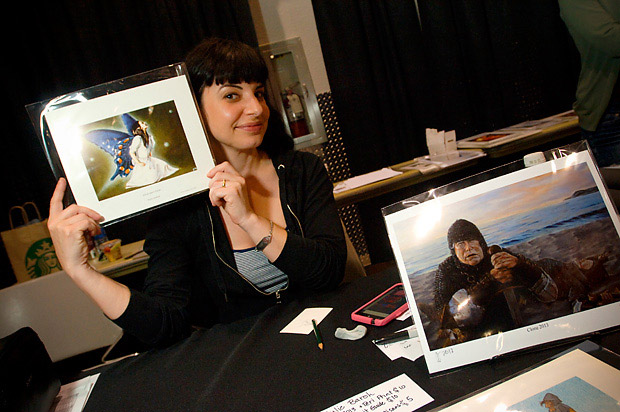
From painting to coding, quite the switch!
Yeah, it was this total 180, but it was kinda fun, I was using another part of my brain, but I didn't do any art at that time. I think in 2007 I started working again in art.
I never really left the Magic world, in many ways I'm still in touch with a lot of people, working on side projects and shows, I'm working on some projects with Drew Tucker, my artwork is out there, and it's very different from what I did 20 years ago, for one I know how to paint.
People have asked me if I would return to do Magic work again, and I don't know if I would, it's a very different game now, and the sensibility is different, the stylization is really different, and I don't think it would be a great fit for me.
You recently shared the story behind Gwendlyn Di Corci a card that remains controversial to this day.
A thing we would do back in the day, when we could get away with it, was we would put little things in our artwork, almost like Easter eggs, until one of our artists got into trouble for writing something in that was sort of nasty.
On Gwendlyn Di Corci was just told "she needs to be sort of a bad-ass warrior queen type character". I asked my friend Wendy - whose full name is Gwendlyn - if she would model for me. She was in a punk rock band from Sub Pop, called Sick and Wrong, and she would perform pretty much nude with like a strap-on dildo. [Laughs]
Of course, I couldn't show her like that, but I figured she is kinda bad-ass in real life, so I figured she's a great model for the piece. Her cat is also in there, and there's even a little letter with the initials of her husband.
I still don't know how Jesper got that one through the Marketing Department. I immediately got wind that it was kind of a trouble card". And the intention wasn't like "oh my god she's gonna rape this guy", that was not the intention at all, it was sort of this ninja mood.
I gave her the artwork as a thank you, and she still has it. Each piece that I did back then has a story behind it.
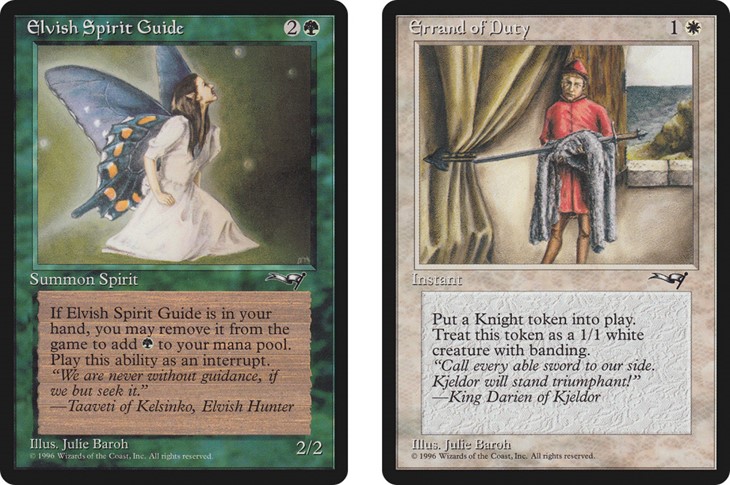
The art descriptions were really vague at the time, right?
We were often left to our own devices. For example, Clone was the first card I did and Jesper's like "ah, it's blue", and I'm like "what does that mean?", and he said "well, throw some water in there, an ocean". [Laughs] So I did two guys standing on the beach, I didn't know what else to do.
Jesper never really said we had terrible ideas, he usually helped us flesh it out. It wasn't until 95 or 96 that they really started to hammer down the style guide and the the story, and got more specific on how it needed to look, and that part I totally understand.
The part that frustrated me was how panicky the Marketing Department got when the game came out, with worries of being offensive. They started to really get on us to be as homogeneous as possible, which is a little frustrating, because it really cuts back on how creative you can get.
It's not even that they didn't want to offend, they just didn't want to cause trouble, you know, especially after Shuler's Demonic Tutor really caused problems.
Really?
Oh god, yes! The Christian rights, and the game was demonic, and during that time a kid in Florida killed a bunch of people, and turned out he was really into Magic, so suddenly the game was in the news, with how it was making kids go crazy and kill people, which is stupid.
I guess you can see the devil in everything. I was like "don't let it win", you know? Don't let the fear and negative stuff win out. So that was kind of sad for me, cards were being pulled from the game, and that there's this fear that we were going to do something terrible [Laughs].
I think they just wanted to make a game and not have the art be a problem, and I totally get it, but I got a little burnt out that the art had to jump through non-creative groups to get approved, you know? Marketing people are not always the most creative and open-minded people on earth.
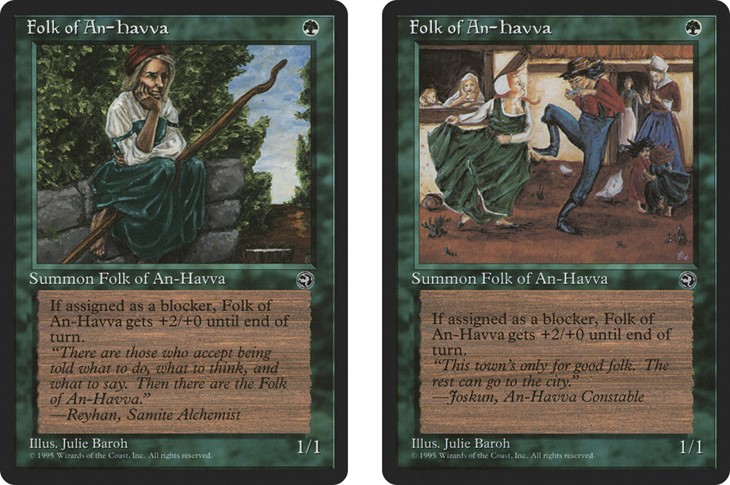
Did you keep any of the originals you made?
Yeah. Actually, they gave us back all the originals and sketches, and we were allowed to display and sell the art. As you know, a lot of the early art is now worth a lot of money.
A piece of mine, Underworld Dreams, just sold on auction for $31,000, which is sort of bizarre to me, because it's a little 5x7 tiny piece that I did in college! and it's kind of funny that any work I did in college will out sell any work I do since.
I don't own any of the original art anymore, I think I have like one sketch left. Back then, when the game got popular, one way to make money was to sell the original art, so we sold all the original art and sketches for nothing" I mean, I sold the original Clone for $100. So obviously, it is weird to see things go up for auction...
In the early days, the contracts were quite a bit different from what they are now. I don't wanna go into it because some of it is not pleasant, but there was a lot of politicking on how much artists should get, and it's one of the reasons why a lot of the original artwork was re-imagined by other artists.
I get asked a lot about the whole thing, because I was actually really prominent, especially in 96, with some of the changing that happened with the re-issues with the contracts, and how the original art was being handled, and honestly, it wasn't as dramatic as people play it out. It came off that way because some of the stuff that was going on seemed pretty ludicrous.
When money and licensing is put into play, people get very... [Pause] impassioned [Laughs], and back then, for us, it was more about making sure that things were honored in our original contracts, and that we were being fairly treated.
I personally wanna keep the focus on the positive stuff that went down because that was way more important, that's really the legacy, not the stupid business stuff.
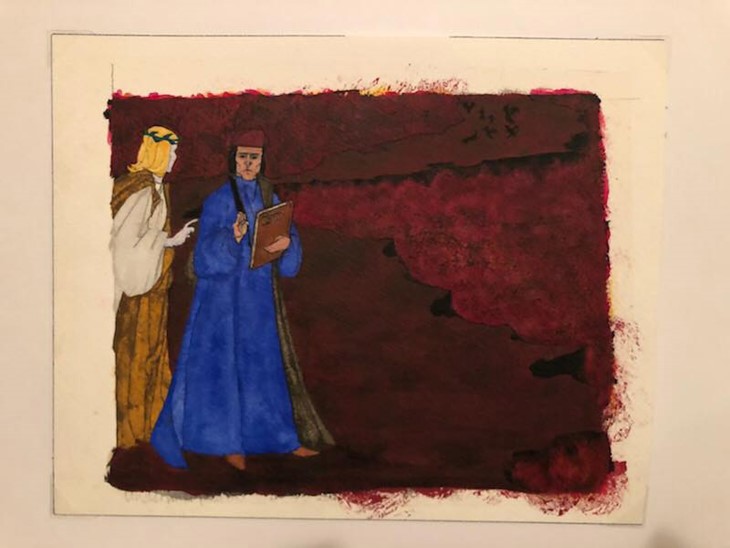
Yeah, and you've got your name on one of the most important games of all time.
It changed. Our. Lives. You cannot deny, if you were involved in those days, how much that game changed your life and your trajectory. I would be a very different person if that game hadn't came around. It forever ties me into a phenomenon that I'm actually pretty proud of. I've seen so many amazing things come out of this game and I've heard so many great stories from the players of how this game positively affected their lives.
I'm really happy I was part of it, even if it was a small part, I didn't do 100 cards or whatever, it still meant a lot to me, and I still stay in touch with a lot of the people from back then, I made a lot of really really good friends through that game. I am absolutely thankful for what it gave me and I have nothing but good to say about the game.
I picked my top three favorite cards of yours, so if there's something you'd like to share about them, please do!
Okay!
Number three: Mind Twist.
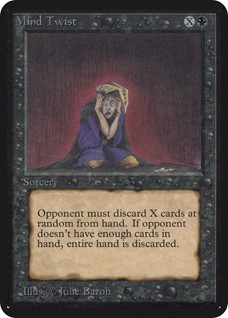
Mind Twist was one of the first four cards I worked on, it was done in color pen and ink, and it's a little tiny painting of 5x7 inches, that was the size of the scanner we were scanning all the art in.
Again, I was given very little direction on, except that it was dark, twisted, painful, black. As I have chronical migraines, this was the worst wizard hangover you can imagine. I just wanted to paint a little guy with this massive headache, 'cause that's how I felt when I get mine.
My number two is Aladdin.
That's a good tie-in. The colors that I used on that piece were sort of 'acidic', a lot of yellows and greens. Obviously I wanted to use the real story of Aladdin, who in the story lived on the Chinese Silk-road, that's why he's dressed in Chinese clothing. At the time, I was having really bad headaches, and when you have a really tight deadline, you have to work no matter what. When I was working on that piece, I had the most unbelievable migraine on earth, and my palette changes when I have a headache, so colors that I end up using - because my vision changes a bit - really reflected how I was feeling. The colors are very different than what I normal work in.

And my favorite is Kobold Drill Sergeant!
Oh Yeah, Kobold Drill Sergeant! [Laughs] At the time I was thinking of General Patton, my muse for that card, I think I had watched George C. Scott in Patton at the time. All the cards for the Kobolds I used my Dad, uh, he doesn't look like a Kobold! [Laughs] but I kinda used his likeness for all my Kobolds, including the little Kobolds of Kher Keep, the little girl Kobold, she kinda looks like my dad. I actually gave the Kobold Overlord to my dad as a present, so the Kobolds all have a little of my dad in them. He was really into the game, he thought the game was awesome, and was really excited about it, so it just seemed like a natural fit to make him into a Goblin. [Laughs]
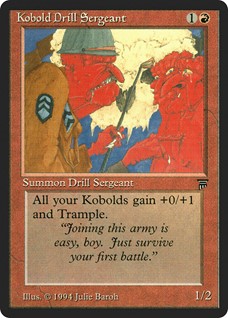
And what's your favorite?
Not necessarily for the style, but just for the content, my favorite would probably be the last card I did which was Foul's Tome. It isn't a very well-known popular card but there's the book element to it, I collect old books and things, and the little character inside is doing the esoteric "so above, so below" thing.
In terms of game-play, my favorite would probably be the first card I did, Clone. In 2013, we did a book, the first 49 Magic artists, on the 20 years of the game, and I redid Clone, which was a lot of fun. Clone was also the first card I did and so it has that sentimental value.
So I would probably pick those two, first and last card. [Laughs]
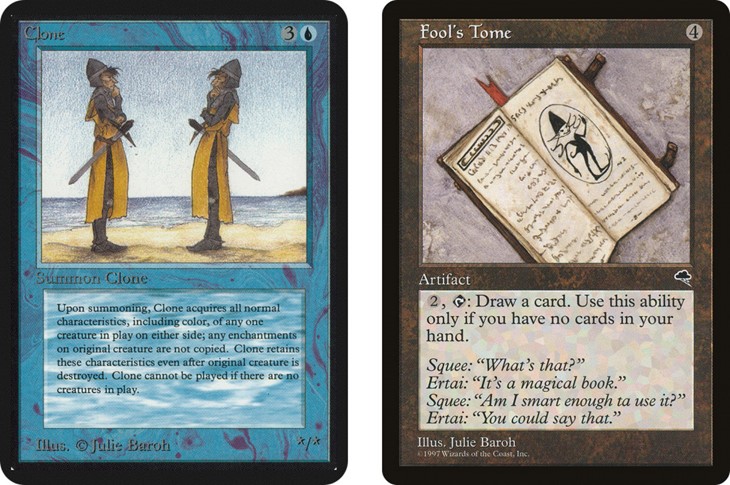
We wholeheartedly thank Julie for her time, passion and kindness!
You can learn more about Julie on her website , she also shows her artwork on Instagram - make sure to follow her there - and she's also around Facebook!
We also highly recommend you check out Julie's blog, Hugo Howls, where Julie shares and writes about her work on a more personal level.
